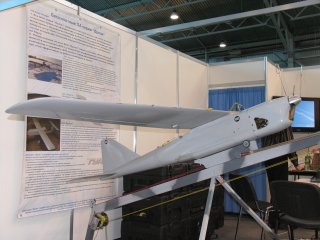Russian Orlan-10 Drones Deployed in Siberia and Tajikistan Drills
Moscow has invested heavily in drones in recent years.
The Russian Orlan-10 medium-range, multipurpose unmanned aerial vehicle (UAV), has been in service for a decade and it has been used in a variety of rugged terrains. This week it was further tested in the Kemerovo Region of southwestern Siberia. Teams from the motor rifle large unit of the Central Military District's 41st all-arms army used the UAVs to deliver precision artillery strikes during a live fire exercise.
"During the drills, the teams of Orlan-10 unmanned aerial vehicles adjusted the artillery fire, searched for command posts and communications centers and further reconnoitered the area of the deployment of a notional enemy's reserves in the daytime and at night," the Central Military District's press office told state media. "Special attention was paid to accomplishing one of the most complex elements: the drones' precision landing."
The Orlan-10 teams accomplished more than 20 fire assignments during the Siberian drills, which involved over 500 personnel and more than 50 items of military hardware.
According to a report from Army-Technology, the UAV platform was also deployed in a one-day training exercise with the Russia Army's 201st military base tankers that was conducted in the Lyaur training ground in the mountains of Tajikistan. The UAVS were used to discover masked targets and communicate the information back to the command post, which allowed Russian T-72 tank crews to conduct attacks on the simulated enemy locations.
The Orlan-10 UAV platform consists of the actual unmanned aerial vehicles along with launch and recovery systems, ground control segment, and swappable payloads. It features a modular design with high-wing configuration, while its tail section comprises a tail plane and a vertical stabilizer. The UAV has multiple camera systems including a day-light camera, thermal imaging camera, a video camera and a radio transmitter located in the gyro-stabilized pod fitted under the fuselage. These provide an "eye in the sky" that offers real-time intelligence, 3D maps, surveillance and aerial reconnaissance of ground-based targets.
The Orlan 10 can be used in a variety of missions including aerial reconnaissance, observation, monitoring, search and rescue, combat training, jamming, detection of radio signals and target tracking. It is part of the latest Russian military investment in electronic warfare capabilities. It can execute missions in both autonomous and remote control modes.
The UAV system is powered by an internal combustion engine, which drives a two-blade propeller mounted in the nose. The unarmed drone can transmit telemetry data to a range between 120km and 600km from the launch station and endure for approximately 18 hours. It can fly in all weather conditions.
Russia has invested heavily in drones in recent years, and as The National Interest previously reported, Russian Central Design Bureau for Marine Engineering Rubin is looking to take this up a notch and is working on the creation of a global network of underwater, surface and air drones.
The United States has also upped its "drone game," and has seen AI and networked drones as a tool in waging future conflict. The U.S. military already employs drones such as the RQ-4 Global Hawk to provide an extra set of eyes in the sky in hostile regions. Global Hawk UAVs were deployed earlier this month in the South China Sea amidst increasing tensions with China in the region.
Peter Suciu is a Michigan-based writer who has contributed to more than four dozen magazines, newspapers and websites. He is the author of several books on military headgear including A Gallery of Military Headdress, which is available on Amazon.com.

